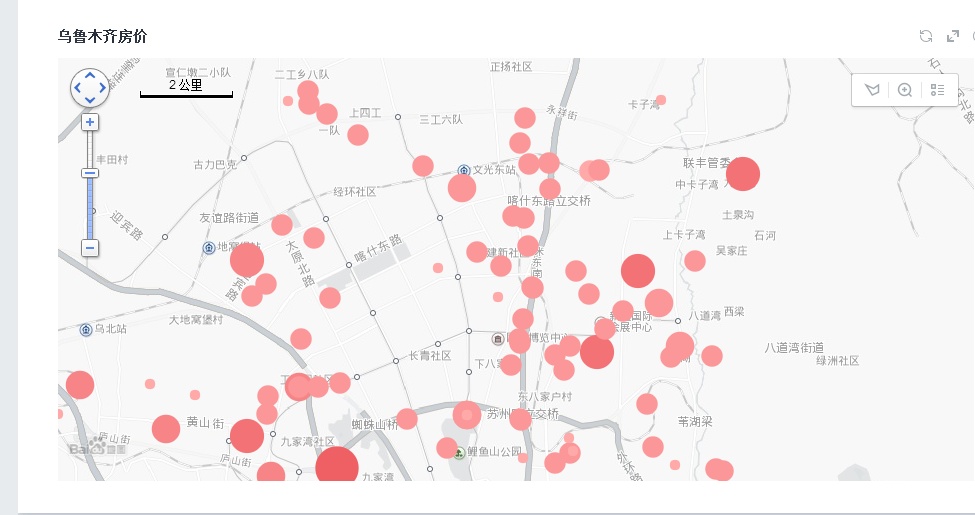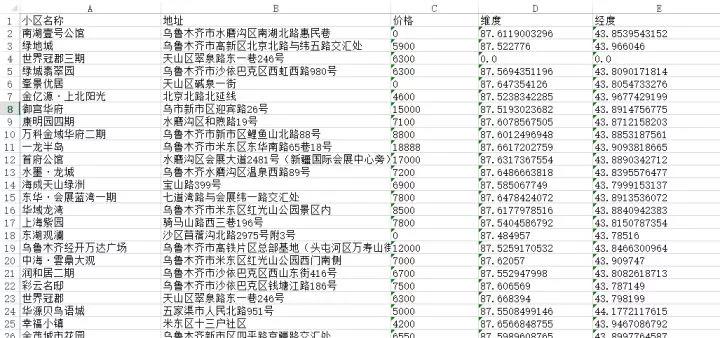小伙伴,我又来了,这次我们写的是用python爬虫爬取乌鲁木齐的房产数据并展示在地图上,地图工具我用的是 BDP个人版-免费在线数据分析软件,数据可视化软件 ,这个可以导入csv或者excel数据。
- 首先还是分析思路,爬取网站数据,获取小区名称,地址,价格,经纬度,保存在excel里。再把excel数据上传到BDP网站,生成地图报表
本次我使用的是scrapy框架,可能有点大材小用了,主要是刚学完用这个练练手,再写代码前我还是建议大家先分析网站,分析好数据,再去动手写代码,因为好的分析可以事半功倍,乌鲁木齐楼盘,2017乌鲁木齐新楼盘,乌鲁木齐楼盘信息 - 乌鲁木齐吉屋网 这个网站的数据比较全,每一页获取房产的LIST信息,并且翻页,点进去是详情页,获取房产的详细信息(包含名称,地址,房价,经纬度),再用pipelines保存item到excel里,最后在bdp生成地图报表,废话不多说上代码:
JiwuspiderSpider.py
- # -*- coding: utf-8 -*-
- from scrapy import Spider,Request
- import re
- from jiwu.items import JiwuItem
- class JiwuspiderSpider(Spider):
- name = "jiwuspider"
- allowed_domains = ["wlmq.jiwu.com"]
- start_urls = ['http://wlmq.jiwu.com/loupan']
- def parse(self, response):
- """
- 解析每一页房屋的list
- :param response:
- :return:
- """
- for url in response.xpath('//a[@class="index_scale"]/@href').extract():
- yield Request(url,self.parse_html) # 取list集合中的url 调用详情解析方法
- # 如果下一页属性还存在,则把下一页的url获取出来
- nextpage = response.xpath('//a[@class="tg-rownum-next index-icon"]/@href').extract_first()
- #判断是否为空
- if nextpage:
- yield Request(nextpage,self.parse) #回调自己继续解析
- def parse_html(self,response):
- """
- 解析每一个房产信息的详情页面,生成item
- :param response:
- :return:
- """
- pattern = re.compile('<script type="text/javascript">.*?lng = \'(.*?)\';.*?lat = \'(.*?)\';.*?bname = \'(.*?)\';.*?'
- 'address = \'(.*?)\';.*?price = \'(.*?)\';',re.S)
- item = JiwuItem()
- results = re.findall(pattern,response.text)
- for result in results:
- item['name'] = result[2]
- item['address'] = result[3]
- # 对价格判断只取数字,如果为空就设置为0
- pricestr =result[4]
- pattern2 = re.compile('(\d+)')
- s = re.findall(pattern2,pricestr)
- if len(s) == 0:
- item['price'] = 0
- else:item['price'] = s[0]
- item['lng'] = result[0]
- item['lat'] = result[1]
- yield item
item.py
- # -*- coding: utf-8 -*-
- # Define here the models for your scraped items
- #
- # See documentation in:
- # http://doc.scrapy.org/en/latest/topics/items.html
- import scrapy
- class JiwuItem(scrapy.Item):
- # define the fields for your item here like:
- name = scrapy.Field()
- price =scrapy.Field()
- address =scrapy.Field()
- lng = scrapy.Field()
- lat = scrapy.Field()
- pass
pipelines.py 注意此处是吧mongodb的保存方法注释了,可以自选选择保存方式
- # -*- coding: utf-8 -*-
- # Define your item pipelines here
- #
- # Don't forget to add your pipeline to the ITEM_PIPELINES setting
- # See: http://doc.scrapy.org/en/latest/topics/item-pipeline.html
- import pymongo
- from scrapy.conf import settings
- from openpyxl import workbook
- class JiwuPipeline(object):
- wb = workbook.Workbook()
- ws = wb.active
- ws.append(['小区名称', '地址', '价格', '经度', '纬度'])
- def __init__(self):
- # 获取数据库连接信息
- host = settings['MONGODB_URL']
- port = settings['MONGODB_PORT']
- dbname = settings['MONGODB_DBNAME']
- client = pymongo.MongoClient(host=host, port=port)
- # 定义数据库
- db = client[dbname]
- self.table = db[settings['MONGODB_TABLE']]
- def process_item(self, item, spider):
- jiwu = dict(item)
- #self.table.insert(jiwu)
- line = [item['name'], item['address'], str(item['price']), item['lng'], item['lat']]
- self.ws.append(line)
- self.wb.save('jiwu.xlsx')
- return item
最后报表的数据
mongodb数据库
地图报表效果图:https://me.bdp.cn/share/index.html?shareId=sdo_b697418ff7dc4f928bb25e3ac1d52348







































